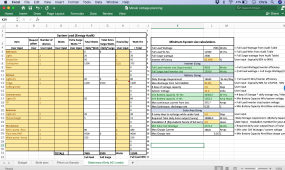Hi all, what I'm looking for here is feedback if I'm crazy to want to install a hydronic in floor heating system off grid.
My wife and I are starting the building plans for a 480 sq-ft off-grid cottage that we plan to use in the winter and summer. We are located in Winnipeg, Canada and the cottage will be a few hours drive away to the east (close to Kenora)
I'm in the process of building up the power demands as we will be off-grid solar. I'm pretty new to this.
I was thinking we would use a standard hot water tank (4500w) and recirculation pump (80w) connected to a thermostat to cycle the solution through the floor.
What I need to know and can't find through the internet, is how long per day will the HWT and circ pump be running? I know that question is dependant on many variables including size of cottage (480 sqft) and insulation values (R30 walls) so I'm just hoping for some directional advice - is this a realistic load to put on a off-grid solar system?
I appreciate any advice or suggestions!
Thanks, Chris
My wife and I are starting the building plans for a 480 sq-ft off-grid cottage that we plan to use in the winter and summer. We are located in Winnipeg, Canada and the cottage will be a few hours drive away to the east (close to Kenora)
I'm in the process of building up the power demands as we will be off-grid solar. I'm pretty new to this.
I was thinking we would use a standard hot water tank (4500w) and recirculation pump (80w) connected to a thermostat to cycle the solution through the floor.
What I need to know and can't find through the internet, is how long per day will the HWT and circ pump be running? I know that question is dependant on many variables including size of cottage (480 sqft) and insulation values (R30 walls) so I'm just hoping for some directional advice - is this a realistic load to put on a off-grid solar system?
I appreciate any advice or suggestions!
Thanks, Chris



